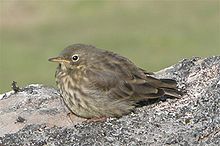European rock pipit: Difference between revisions
m replacing image with one in which the bird is much clearer |
m typo |
||
| Line 1: | Line 1: | ||
{{Taxobox |
{{Taxobox |
||
| image = |
| image = Anthus_petrosus3.jpg |
||
| image_width = |
| image_width = |
||
| image_caption = On [[St Mary's Island, Tyne and Wear]], [[United Kingdom]] |
| image_caption = On [[St Mary's Island, Tyne and Wear]], [[United Kingdom]] |
||
Revision as of 04:18, 5 August 2013
| European rock pipit | |
|---|---|

| |
| On St Mary's Island, Tyne and Wear, United Kingdom | |
| Scientific classification | |
| Kingdom: | |
| Phylum: | |
| Class: | |
| Order: | |
| Family: | |
| Genus: | |
| Species: | A. petrosus
|
| Binomial name | |
| Anthus petrosus (Montagu, 1798)
| |
| Synonyms | |
|
Anthus spinoletta petrosus (Montagu, 1798) | |
The Eurasian Rock Pipit (Anthus petrosus) is a small passerine bird species which breeds on rocky coasts of western Europe northwards from Brittany. It is mainly resident in Ireland, Great Britain and France, in the west of its range, but the Scandinavian and Russian populations migrate south in winter; individuals sometimes stray into inland Europe. In Saxony it is a rarely seen visitor; for example, the Staatliches Museum für Tierkunde Dresden has but a single specimen (C 13347), a male shot at Dresden as long ago as 8 October 1894[2].
It was formerly included within its putative sister species, the Water Pipit (A. spinoletta), as was their slightly more distinct Pacific relative the Buff-bellied Pipit (A. rubescens).[3]
Description, systematics and ecology

Like most other pipits, this is an undistinguished looking species on the ground, mainly dark brown above and heavily streaked buff below. It has dark legs, pale grey outer tail feathers and a longish dark bill. Its dark plumage is an adaptation to the rocky coasts on which it breeds and winters.
West European birds (subspecies A. p. petrosus, A. p. kleinschmidti and A. p. meinertzhageni) remain dark grey-buff all year. Scandinavian and Baltic Sea birds (A. p. littoralis) are usually indistinguishable from petrosus in winter; they may show pinkish underparts and a pale supercilium in summer, resembling the Water Pipit (A. spinoletta). Vagrant birds in winter are easily distinguished from Water Pipits but impossible to assign to subspecies by appearance and measurements. However, the western populations are known to be nearly sedentary, so east of the Elbe basin vagrant Rock Pipits are presumably mostly littoralis[4].
Its call is an explosive fit. The song, as in many pipits, is a series of "blocks" of repeated more or less shrill cheeping single or double notes; it ends on a trill and has usually fewer, but longer-lasting "blocks" (a dozen repetitions or more) than in the Water Pipit.[5]
This species is insectivorous like its relatives, and as usual for Motacillidae seeks out much of its prey on foot. Eurasian Rock Pipits tend to be found along rocky coasts, whereas Water Pipits favour damp grassland. While they may be occur in the same general area occasionally, they are rarely found in the same habitat. The Eurasian Rock Pipit is a much more approachable bird than the Water Pipit. If startled, it flies a fairly short distance, close to the ground, before it lands again.[6]
Footnotes
References
- Alström, Per & Mild, Krister (1987): Some notes on the taxonomy of the Water Pipit complex. Proceedings of the 4th International Identification Meeting (Eilat): 47–48. International Birdwatching Center, Eilat.
- Alström, Per & Mild, Krister (1996): The identification of Rock, Water and Buff-bellied Pipits. Alula 2(4): 161–175.
- Bijlsma, R. (1977) Voorkomen en oecologie van Anthus spinoletta en A. s. littoralis in de uiterwaarden van de Rijn bij Wageningen ["Distribution and ecology of A. spinoletta and A. s. littoralis in the Rhine floodplain at Wageningen"]. Limosa 50: 127–136. [Dutch[verification needed]]
- Leonovich, V. V.; Deminia, G. V. & Veprintseva, O. D. (1997): [On the taxonomy and phylogeny of pipits (Genus Anthus, Motacillidae, Aves) in Eurasia]. Biulleten Moskovskogo obshchestva ispytatelei prirody. Otdel biologicheskii. 102(2): 14–22. [Russian[verification needed]]
- Töpfer, Till (2007): Nachweise seltener Vogeltaxa (Aves) in Sachsen aus der ornithologischen Sammlung des Museums für Tierkunde Dresden [Records of rare bird taxa (Aves) in Saxony from the ornithological collection of the Zoological Museum Dresden]. Faunistische Abhandlungen 26(3): 63-101 [German with English abstract]. PDF fulltext
- Voelker, G. (1999): Molecular evolutionary relationships in the avian genus Anthus (Pipits: Motacillidae). Mol. Phylogenet. Evol. 11(1): 84–94. doi:10.1006/mpev.1998.0555 PMID 10082613 (HTML abstract)

